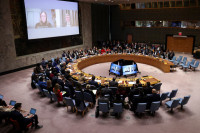Opinion
Things are changing
The rate of child marriage has dropped, and the average age for marriage has gone up
Anjita Parajuli
I met Ashmita Tharu in her village during one of my visits to Bardia to make a documentary on how the lives of former Kamalaris, or child slaves, had changed after gaining their freedom. Ashmita had trained as a junior technical assistant (JTA) in agriculture, acquired a loan from a cooperative, leased a piece of land and was running a successful farming business. At 20 years of age, she was still unmarried despite the fact that child marriage is part of Tharu culture. She said she did not want to marry any time soon, and that her family was also not putting any pressure on her to do so. Her business was thriving, her little sisters and brothers were going to school with the money she was making, and they had plans to build a new house soon.
As shown by Ashmita’s example, Nepal is witnessing a change in the culture of early marriage. The marriageable age is 20 years, and 18 with parental consent. The government has developed a national strategy to end child marriage by 2030. However, these efforts are inadequate. According to the 2011 census, 2.7 million girls between 15 and 19 out of a population of 4.3 million were reported to be married. South Asia has the largest number of child brides and Nepal ranks third in the region.
Causes of child marriage
Early marriage prevails in Nepal due to poverty, illiteracy, cultural factors and weak legal actions. A 2012 report published by Save the Children, World Vision and Plan showed that food security had a positive correlation with the age of marriage: Households with enough food for the year married off their children after they had reached 19. Illiterate girls were more likely to marry early, highlighting the need to bring girls into education and keep them in school. Although marrying off daughters before puberty for religious reasons has most likely become history, a grown-up unmarried daughter is still the greatest burden for her parents. Today, the situation has changed for many in the cities, but the status of girls in the villages is no different.
The good news is that, according to the same 2012 report, child marriage has declined among Brahmins and Chhetris and other major castes; but the bad news is that it has increased among Dalits and ethnic minorities. A look into the child marriage prevention campaign among the Tharu community in western Nepal, who are among Nepal’s most marginalised indigenous groups, could be helpful in understanding the dynamics.
The Tharu community
A study revealed some interesting facts: Out of the 201 girls interviewed from Tharu community, 76 percent said “falling in love” was one of the reasons for marrying young. Giving up studies (21 percent) and family pressure (19 percent) were other key reasons. While the general understanding is that child marriages are forced by families, this finding tends to put the girls themselves at the focus of discussion.
What makes girls marry early? The root cause can ultimately be traced back to culture. Tharus traditionally practiced child marriage. Marriages were pledged during pregnancy, and they were also done to fulfil an economic function: Boys as young as eight years old were married to older girls so that the family would have one more farm hand. This practice has now almost disappeared; but Tharus, unlike Hindu caste groups, are a more open and egalitarian society. A daughter who chooses a boyfriend for herself is not judged harshly, and a girl with a premarital baby can easily find a husband. The culture creates a favourable environment for adolescent girls and boys to become intimate; and since a dating culture does not really exist, they marry. Usually the family arranges the marriage, or in some cases, the boy and the girl marry on their own.
The child marriage prevention campaign has yielded positive results: The rate of child marriage has declined in the community, and the average age for marriage has gone up. The strategies in place like intimate peer counselling and life skills education for girls, and awareness campaigns for parents, community and local leaders and boys have been helpful. People are aware that child marriage is illegal. Girls are going to school, and those out of school are active in the economy which helps to prevent early marriage.
However, the number of early marriages has not dropped to the extent expected, and cultural factors seem to be a major challenge. Early marriages are rarely reported, and even when they are reported, the police do not want to prosecute the cases and prefer to leave them as a personal family matter. According to Man Bahadur Chhetri and Fakala Tharu, who are facilitating the campaign on the ground, the focus should now be put on mobilising the community and putting it at the forefront. They have said that awareness activities yield better results when they are more intensive and done in closed groups rather than publicly in large groups. If the Badghars, or the Tharu community leaders, could be made to fully understand and realise the gravity of the effects of child marriage, they could easily influence the attitude of the entire community. Similar education for adolescent boys can help minimise their tendencies to pressurise girls to marry early, or encourage themselves to marry later.
Issues such as child marriage are culturally sensitive, and when (I)NGOs launch their campaigns in the community to address them, a tension between the two forces is usually created. The community feels vulnerable and that its cultural existence is being threatened. It is, therefore, critical to take the community into confidence. The impact is sustainable when the community owns the cause.
Parajuli is associated with Nepal Youth Foundation




 5.27°C Kathmandu
5.27°C Kathmandu












